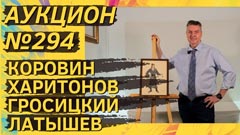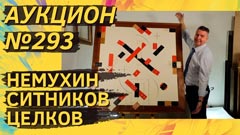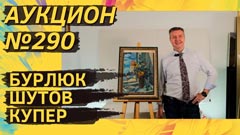
CONTEMPORARY ART
KOSHLYAKOV Valery Nikolaevich (1962) New Arbat. 1997. Canvas, tempera, acrylic. 196 × 143
A large-scale two-meter canvas by Valery Koshlyakov is devoted this time not to distant ancient ruins, but to a part of Moscow's history and the “vanishing beauty” of an iconic place on the map of the capital. Which is a rarity in itself. New Arbat until 1994 was called Kalinin Avenue. It was built after Gagarin's flight into space as a symbol of progress and movement into the future. Some people referred to Kalinin Avenue as “the false jaw of Moscow” and complained that it was cut through barbarously, not sparing the historical buildings. And for others, it became the most progressive place, Moscow's first highway and a fashionable shopping street. The book houses on Kalininsky Prospect became one of the symbols of contemporary Moscow. And in the dashing nineties, when Koshlyakov painted this picture, New Arbat turned into one of the greasy places — with the Metelitsa nightclub, casino and new attributes of the “sweet life”.
Valery Koshlyakov is one of the top 20 most expensive living Russian artists and the top 5 artists of contemporary art. His auction record is $147,000. The artist's favorite theme is a conversation about the loss of classical culture, the elusive beauty and the ruthlessness of time. The “New Arbat” painting, unlike many of his works, is not made on corrugated cardboard, but with durable materials that will not need restoration for hundreds of years. It's a museum-quality piece — this painting has been exhibited more than once.
1960s UNOFFICIAL ART
RABIN Oscar Yakovlevich (1928–2018) A cat on the roof of a barrack. 1961. Oil on canvas. 47 × 80
1961 — Rabin works in a barrack in Lianozovo. No meeting with Estorick yet. No exhibition at the “Druzhba” Culture Center (it will take place in 1967). And nothing forebodes that in front of the artist — the fate of the leader of nonconformist art, the “bulldozer exhibition”, emigration and deprivation of Soviet citizenship. In this year, Rabin dares not dream of success at all. He doesn't know that his art will be admired by thousands of people. He simply looks around and reflects on the theme of barracks life. Will anyone need his paintings? Where to find paints and canvases? How will he make it through the day and the night? It is in this hopelessness, this depressive reflection that such masterpieces are born. Yes, there are barracks all around (well, sorry, there are no palaces nearby). Yes, the leaden sky hangs overhead. But the lantern is burning. And cats are shrieking on the rooftops. And so, there is hope, and life will still take its course.
ZVEREV Anatoly Timofeevich (1931–1986) They are carrying a rocket. 1960. Paper, charcoal, tempera. 42.5 × 60
This drawing comes from the collection of the legendary George Costakis. It is a rare subject for Zverev. Cosmic! However, why be surprised. At the end of the 1950s the country was dreaming about outer space. In 1957, the rocket RG-7 put into orbit the first artificial Earth satellite, and the word “satellite” entered many languages. In 1960 (the year of the drawing), Voinovich wrote the words to the song “The space maps are loaded into the tablets”. The whole country is dreaming of the great.
For Zverev, the period of the late 1950s — early 1960s is considered one of the most fruitful and valuable. The artist is young, full of strength, relaxed and not afraid of creative experimentation. This work is among the best samples of his work. It is no coincidence that Valery Silaev gives it the rating “has museum value”.
RUKHIN Evgeny Lvovich (1943–1976) Composition with the image of the Virgin. 1974. Masonite, oil, PVA, tempera, collage from a reproduction of the icon, epoxy resin. 46.5 × 45
A chamber work with a protesting religious theme for the USSR and a convenient “suitcase” size. Such a painting was convenient for a diplomat or correspondent leaving the USSR to take with him on the road. Most likely that is how this painting ended up abroad. “Composition with the image of the Virgin” refers to the mature period of Rukhin's creativity. He had already fully mastered his proprietary technology of working with glues, resins and varnishes that form the inimitable texture of his paintings.
YAKOVLEV Vladimir Igorevich (1934–1998) Faces. 1982. Paper, black pencil, gouache. 53.5 × 41.5
Another rarity! A very unusual story! Valery Silaev, an expert and researcher of Vladimir Yakovlev's work, notes that this is “a very interesting work, with its own unique view of the world, the relationship between man and nature, its own kind of plasticity and energy”. Yakovlev at this time suffered a tragic period, strongly losing his sight. Nevertheless, even during this difficult period, he produced particularly strong phantasmagoric analytical compositions.
CONTEMPORARY ART
SAVKO Alexander Andreevich (1957) Yes, everything is in the past... 2021. Acrylic on canvas. 70 × 100
The author's idea is based on the palimpsest of the painting “Everything is in the past” (1889) by the “Itinerant” artist Vassily Maksimov (1844–1911), which is in the collection of the Tretyakov Gallery. The painting of an elderly lady living out her years in a neglected manor became one of the most penetrating works of Russian art of the late 19th century. Some see it as a story of the Dragonfly, that “sang all through the summer”. Someone, on the contrary, empathizes with the end of a once affluent and influential family. A good genre painting, like a good novel, has many plots. It is no coincidence that for Maximov this painting was the pinnacle of creativity and at the same time a creative curse. He wrote quite a few paintings, but none surpassed “Everything is in the past” in fame. For him, it became as “The Rooks Have Arrived” for Savrasov or “The Vision to the Youth Bartholomew” for Nesterov. It is known that Maksimov painted about 40 repetitions of the painting that was beloved by the customers.
Savko's reinterpretation gives this story a new life. And a new ending. To the tragedy of the noblemen's nests is added a plot from “Men in Black”. The bugs drinking “Good Coke” — who are they? Our new neighbors? Or winners? An uneasy twist for the new owners to rethink.
- Log in to post comments










